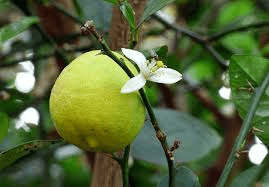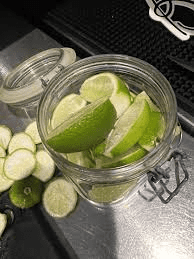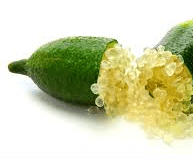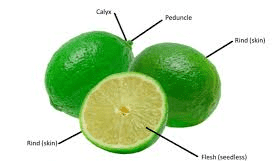The lime peduncle is an essential part of the lime fruit’s structure, playing a crucial role in its growth and development. Scientifically termed as the fruit stalk or stem, the peduncle connects the fruit to the main branch of the lime tree. It serves several important functions throughout the fruit’s lifecycle.
Firstly, the peduncle acts as a conduit, providing a pathway for nutrients and water from the tree to the developing fruit. This transport system ensures that the lime fruit receives essential resources for growth and maturation. Nutrients such as sugars, minerals, and hormones are transported through the peduncle to support the fruit’s development from its initial stages as a small, green bud to its mature, harvest-ready state.
Additionally, the peduncle plays a role in anchoring the fruit to the tree. As the lime fruit grows and increases in size, the peduncle provides structural support, keeping the fruit attached securely to the branch despite external forces such as wind or rain. This stability is crucial for preventing premature fruit drop and ensuring that the fruit remains on the tree until it reaches optimal ripeness.
The peduncle also serves as a site for communication between the fruit and the tree. Chemical signals and hormones produced by the developing fruit can be transported back through the peduncle to the tree, influencing various physiological processes. These signals may regulate fruit development, ripening, and even trigger responses in the tree to allocate resources effectively.
In terms of morphology, the peduncle of a lime fruit is typically slender and elongated, varying in length depending on the specific variety of lime. It connects the fruit to the tree at a point where the fruit develops from the flower’s ovary after successful pollination and fertilization. This developmental origin underscores the peduncle’s role as a bridge between reproductive success (flowering and pollination) and fruit formation in the life cycle of lime trees.
Throughout the growth of the lime fruit, from its initial formation on the peduncle to its eventual maturity and harvest, the peduncle remains integral. It facilitates the ongoing exchange of nutrients, provides structural support, and contributes to the overall health and development of the fruit. Understanding the importance of the lime peduncle sheds light on the intricate processes involved in fruit growth and the interplay between tree physiology and fruit production in citrus agriculture.
The Economic Importance and Uses of Lime Peduncle

1. Compost Material: Lime peduncles can be composted to enrich the soil with nutrients, promoting healthy plant growth.
2. Animal Feed: Dried and processed lime peduncles can be used as a component in animal feed, providing a source of fiber.
3. Mulching: Shredded lime peduncles can be used as mulch to retain soil moisture and prevent weed growth in gardens.
4. Biofuel Production: Lime peduncles can be converted into biofuel through processes like fermentation and anaerobic digestion.
5. Crafting: The sturdy nature of dried lime peduncles makes them useful in crafting items such as wreaths and decorations.
6. Biodegradable Products: Lime peduncles can be processed to create biodegradable products like packaging materials and disposable cutlery.
7. Paper Production: Lime peduncles can be used as a raw material in the production of paper and cardboard.
8. Soil Erosion Control: Using lime peduncles in erosion control helps stabilize soil and prevent erosion on slopes and embankments.
9. Medicinal Uses: Extracts from lime peduncles have potential medicinal properties and are studied for their anti-inflammatory and antimicrobial effects.
10. Natural Fertilizer: Lime peduncles, when decomposed, act as a natural fertilizer, adding organic matter and nutrients to the soil.
11. Biochar Production: Lime peduncles can be converted into biochar, which improves soil fertility and sequesters carbon.
12. Activated Carbon: Lime peduncles can be processed into activated carbon for use in water filtration and purification systems.
13. Food Additives: Extracts from lime peduncles are sometimes used as natural food additives for flavoring and preservation.
14. Essential Oils: The peduncle may contain compounds that can be extracted for essential oil production, although less common than from the fruit and leaves.
15. Industrial Applications: Processed lime peduncles can be used in various industrial applications, such as manufacturing adhesives and sealants.
16. Livestock Bedding: Shredded lime peduncles can be used as bedding material for livestock, providing a comfortable and absorbent layer.
17. Soil Amendment: Lime peduncles can be added to soil to improve its structure and increase its organic content.
18. Renewable Energy: Lime peduncles can be used as biomass in renewable energy production, contributing to sustainable energy solutions.
Read Also: How to Raise Catfish and Tilapia in the Same Fish Pond at the Same Time
The Products and By-products That Can Be Derived From Lime Peduncle

1. Compost: Lime peduncles are decomposed through composting to create nutrient-rich compost for soil improvement.
2. Animal Feed: Dried and ground lime peduncles are mixed into animal feed formulations to provide fiber and nutrients.
3. Mulch: Shredded lime peduncles are used as mulch in gardens to retain moisture and suppress weeds.
4. Biofuel: Lime peduncles are fermented or digested anaerobically to produce biofuel.
5. Craft Items: Dried lime peduncles are used in making wreaths, decorations, and other craft items.
6. Biodegradable Packaging: Processed lime peduncles are used to create biodegradable packaging materials.
7. Paper and Cardboard: Lime peduncles are pulped and processed to manufacture paper and cardboard products.
8. Erosion Control Mats: Lime peduncles are used to make erosion control mats for stabilizing soil on slopes.
9. Medicinal Extracts: Extracts from lime peduncles are obtained through various extraction methods for potential medicinal use.
10. Organic Fertilizer: Decomposed lime peduncles are used as organic fertilizer to enrich soil.
11. Biochar: Lime peduncles are converted into biochar through pyrolysis for soil amendment and carbon sequestration.
12. Activated Carbon: Lime peduncles are processed into activated carbon for filtration and purification purposes.
13. Natural Flavorings: Extracts from lime peduncles are used as natural flavoring agents in food products.
14. Essential Oils: Lime peduncles are distilled to extract essential oils, although less common.
15. Industrial Adhesives: Processed lime peduncles are used in manufacturing industrial adhesives and sealants.
16. Livestock Bedding: Shredded lime peduncles are used as bedding material for livestock.
17. Biomass Energy: Lime peduncles are used as biomass in energy production, contributing to renewable energy sources.
Read Also: The Best Specie of Fish to Raise for Profit
Frequently Asked Questions (FAQ’s) About Lime Peduncle

1. What is a lime peduncle?
The lime peduncle is the stalk that supports the lime fruit and connects it to the tree.
2. How is the lime peduncle used in agriculture?
It can be composted, used as mulch, or converted into biochar to improve soil health and fertility.
3. Can lime peduncles be used in animal feed?
Yes, dried and processed lime peduncles can be included in animal feed to provide fiber and nutrients.
4. What are the environmental benefits of using lime peduncles?
Using lime peduncles for compost, biofuel, and biochar production helps reduce waste and supports sustainable practices.
5. Are there any medicinal uses for lime peduncles?
Extracts from lime peduncles are studied for their potential anti-inflammatory and antimicrobial properties.
6. How can lime peduncles be used in crafting?
Dried lime peduncles are used to make decorative items such as wreaths and floral arrangements.
7. What industrial applications do lime peduncles have?
Lime peduncles can be processed into biodegradable packaging, paper products, and industrial adhesives.
8. Can lime peduncles be used for renewable energy production?
Yes, lime peduncles can be converted into biofuel and used as biomass in renewable energy systems.
9. How do lime peduncles benefit soil health?
They can be composted or converted into biochar, adding organic matter and nutrients to the soil and improving its structure.
10. Are lime peduncles used in any food products?
Extracts from lime peduncles can be used as natural flavoring agents in food and beverages.
Read Also: Banana Tree Care: What You Need to Know

